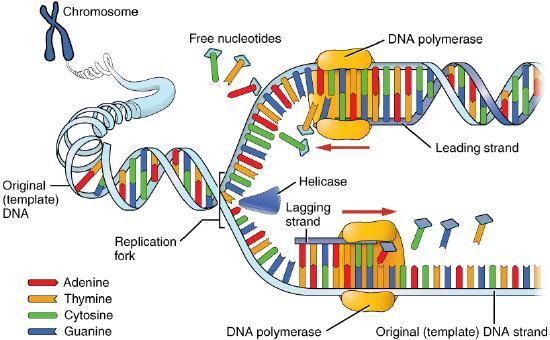Answer:
In DNA replication, cell machinery copies strands of DNA.
Explanation
DNAs, deoxyribonucleic acids, are long-chain, helical macromolecules made of specific sequences of covalently bonded monomers called nucleotides. These contain genetic information essential for growth, reproduction, and cell repair.
Nucleotide monomers are made up of, a 5-Carbon deoxyribose sugar, one nitrogenous base (adenine, guanine thymine, and cytosine) and a phosphate group.
Nucleotides, deriving their name from their nitrogenous bases, pair up to form base pairs. In base-pair formation, Adenine and Thymine form double bonds, while cytosine forms triple bonds with guanine...
- DNA polymerase facilitates either DNA synthesis, by adding free nucleases to parent strands -these are first unwound and separated by helicases
- DNApolys synthesize DNA in 5'-3' direction; due to its restricted movement, there are only two modes of replication: continuous from the point of strand separation, the fork, and discontinuous from the fork.
- In continuous replication, DNApolymerase moves uninterrupted along the 3'-5 oriented template, adding nucleotides to the free hydroxyl group at its 3' end to produce the 5'-3' oriented leading strand.
- During the synthesis of the 3'-5' oriented lagging strand, DNApolymerase moves backwards along the template from the replication fork; DNA helicase separates the strands, and DNApoly's addition of nucleotides is periodically interrupted while forming discontinuous Okazaki fragments. Ligase enzymes assemble nucleotide strands of RNA and DNA -here, DNAligase assembles these fragments into continuous strands, producing two identical new helixes formed from a parent and newly replicated strand respectively.
